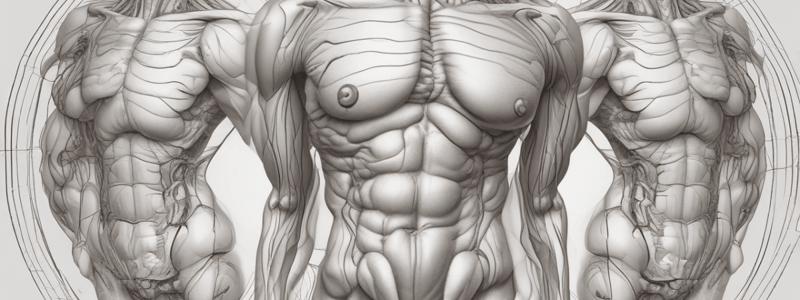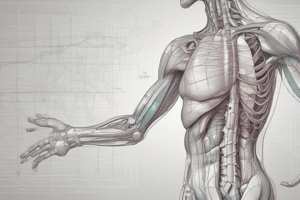Podcast
Questions and Answers
What is the main function of the ligaments in the mesenteries?
What is the main function of the ligaments in the mesenteries?
- To attach the organs to the abdominal wall
- To absorb nutrients from the digestive system
- To separate the organs from each other
- To connect organs to each other (correct)
What is the name of the ligament that connects the liver to the stomach?
What is the name of the ligament that connects the liver to the stomach?
- Gastrosplenic ligament
- Gastrohepatic ligament (correct)
- Falciform ligament
- Lesser omentum
What is the main function of a mesentery in the abdominal cavity?
What is the main function of a mesentery in the abdominal cavity?
- To support the gut and contain fat, nerves, and blood vessels (correct)
- To facilitate the movement of the gut tube
- To connect the gut to the diaphragm
- To divide the abdominal cavity into compartments
During development, which organ grows at an enormous rate and forces other organs to the left?
During development, which organ grows at an enormous rate and forces other organs to the left?
What is the region called where the right side of the peritoneal cavity is pushed backwards behind the stomach and lesser omentum?
What is the region called where the right side of the peritoneal cavity is pushed backwards behind the stomach and lesser omentum?
What is the term for the space between the folds of the peritoneum over the pelvic organs?
What is the term for the space between the folds of the peritoneum over the pelvic organs?
What is the origin of the term 'mesentery'?
What is the origin of the term 'mesentery'?
Which ligament connects the spleen and kidneys?
Which ligament connects the spleen and kidneys?
What occurs to the mesenteries during the development of the gastrointestinal tract?
What occurs to the mesenteries during the development of the gastrointestinal tract?
What is the name of the ligament that connects the liver to the anterior wall?
What is the name of the ligament that connects the liver to the anterior wall?
Which of the following is NOT a correct name for the ligament between the liver and stomach?
Which of the following is NOT a correct name for the ligament between the liver and stomach?
What is the purpose of the dorsal mesentery?
What is the purpose of the dorsal mesentery?
What is the difference between 'intra-peritoneal' and 'retro-peritoneal'?
What is the difference between 'intra-peritoneal' and 'retro-peritoneal'?
What is the term for the space between the greater sac and the lesser sac?
What is the term for the space between the greater sac and the lesser sac?
What is the term for the double-fold of membrane supporting the gut?
What is the term for the double-fold of membrane supporting the gut?
What is the plural form of the term 'mesentery'?
What is the plural form of the term 'mesentery'?
What is the term for the double layer of peritoneum that attaches the stomach to other organs?
What is the term for the double layer of peritoneum that attaches the stomach to other organs?
During the rotation of the stomach, which side of the stomach becomes posteriorly oriented?
During the rotation of the stomach, which side of the stomach becomes posteriorly oriented?
What is the term for the rotation of the midgut driven by the expansion of the liver?
What is the term for the rotation of the midgut driven by the expansion of the liver?
What is the direction of the longitudinal rotation of the stomach?
What is the direction of the longitudinal rotation of the stomach?
What are the two mesogastria that attach to the front and back of the stomach?
What are the two mesogastria that attach to the front and back of the stomach?
What is the main axis of rotation of the stomach during development?
What is the main axis of rotation of the stomach during development?
What is the result of the left side of the stomach facing after the longitudinal rotation?
What is the result of the left side of the stomach facing after the longitudinal rotation?
What are the nerves located on either side of the stomach during development?
What are the nerves located on either side of the stomach during development?
What is the primary mechanism by which the greater omentum localises infections?
What is the primary mechanism by which the greater omentum localises infections?
What is the main route by which lymphocytes are brought to the site of infection in the abdominal cavity?
What is the main route by which lymphocytes are brought to the site of infection in the abdominal cavity?
What is the name of the ligament that forms as a result of the fusion of the layers?
What is the name of the ligament that forms as a result of the fusion of the layers?
What is the purpose of cutting through the gastrocolic ligament during surgery?
What is the purpose of cutting through the gastrocolic ligament during surgery?
What is the term used to describe the greater omentum due to its role in localising and trapping infections?
What is the term used to describe the greater omentum due to its role in localising and trapping infections?
What is the relationship between the greater omentum and the peritoneal spaces?
What is the relationship between the greater omentum and the peritoneal spaces?
Which structure is formed as a result of the fusion of the greater omentum with the transverse colon?
Which structure is formed as a result of the fusion of the greater omentum with the transverse colon?
What is the Greek word for the omentum, associated with the phrase 'to float upon'?
What is the Greek word for the omentum, associated with the phrase 'to float upon'?
What is the name of the connection between the lesser sac and the greater sac?
What is the name of the connection between the lesser sac and the greater sac?
Which part of the stomach grows faster than the other during development, forming the curvatures?
Which part of the stomach grows faster than the other during development, forming the curvatures?
What is the origin of the term 'omentum'?
What is the origin of the term 'omentum'?
What is the name of the ligament that connects the stomach to the liver?
What is the name of the ligament that connects the stomach to the liver?
What is the term for the cavities above and below the stomach?
What is the term for the cavities above and below the stomach?
Which nerve innervates the anterior wall of the stomach in the adult?
Which nerve innervates the anterior wall of the stomach in the adult?
Flashcards are hidden until you start studying
Study Notes
Mesenteries
- A mesentery is a double-fold of membrane supporting the gut, containing fat, nerves, and blood vessels.
- The term "mesentery" comes from the Greek words "meso" meaning middle and "enteros" meaning gut.
Ligaments
- Ligaments are parts of the mesenteries that connect organs.
- Examples of ligaments include the falciform ligament (connects the liver to the parietal peritoneum), gastrohepatic ligament (connects the liver and stomach), and gastrosplenic ligament (connects the stomach and spleen).
Development of the Peritoneal Sacs
- The liver grows rapidly and expands to the right, pushing other organs (stomach, spleen) to the left.
- The liver remains connected to the anterior wall via the falciform ligament.
- The right side of the peritoneal cavity is pushed backwards behind the stomach and lesser omentum, forming the lesser sac.
- The left side of the peritoneal cavity expands and becomes the greater sac.
- There is a connection between the two sacs under the lower border of the lesser omentum.
Greater and Lesser Omenta
- The greater omentum is attached to the greater curvature of the stomach and hangs down in front of the intestines like an apron.
- The lesser omentum is attached to the lesser curvature of the stomach.
- The greater omentum fuses with the transverse colon to form a gastrocolic ligament.
- The omentum contains many omental blood vessels and is full of fat.
Abdominal Cavity Sacs
- The peritoneal cavity is divided into a lesser sac located behind the stomach and a greater sac (everywhere else).
- The epiploic foramen is a connection between the two sacs just under the right (inferior) free edge of the lesser omentum.
Functions of the Greater Omentum
- The greater omentum localizes infections by sticking to infected regions and trapping them.
- The omentum brings lymphocytes to infected regions to help tackle infections, earning it the nickname "abdominal policeman".
Studying That Suits You
Use AI to generate personalized quizzes and flashcards to suit your learning preferences.


